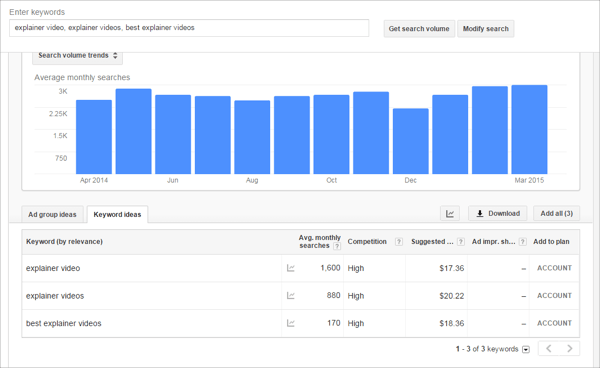
You know it and we know it – being visible on YouTube has become essential to any company that wants to promote their brand through video marketing.
The problem is that being found by your potential customers on YouTube isn’t that easy – you have to beat millions of competitors with larger budgets and brighter videos.
Being visible on YouTube and ranking high in its search results requires thorough search engine optimization (SEO), a wise distribution plan and, above all, a quality marketing video.
Today you’ll learn the basics on how to rank number one on YouTube with your own video. But I’ll not just describe how to do it; I’ll explain and demonstrate each step by using a successful case study from Yum Yum Videos: their explainer video got ranked number one on YouTube under the most valuable business keywords in just 3 months, so it will serve us as a clear example on each step.
You can also get the free step-by-step eBook “How To Rank #1 on YouTube” which expands on this effective strategy.
Now let’s start this exciting video SEO journey with the first question:
Why YouTube?
You might wonder: why choose YouTube as a video hosting site? And why spend time and effort reading this piece to gain a good position in its search engine rankings?
First of all, with over 1 billion active users worldwide, YouTube is the 2nd largest search engine in the world (behind its owner Google, but above Yahoo! and Bing) so it’s not just an average hosting site.
Then, what many people don’t take into account is that YouTube is also a massive social network; it actually happens to be the world’s 3rd largest social network, behind Facebook and Twitter.
This alone makes YouTube a perfect spot on the web to promote your brand.
But the thing is, you can’t really be on YouTube without a video, and even then: you won’t rank high in the search engine without a quality marketing video, simply because yours need to stand out among the 4 billion videos that are watched on it every day… and that leads us to the next point.
The importance of having a quality video
The problem with marketing videos is that you need to make a quality one, or else YouTube will send it to the dark bottom of its page results, even if you spend your whole budget on advertising.
Why is that? Because YouTube cares a lot about complete video views, and the amount of time people spend watching a video is one of the factors YouTube cares about when setting up its SERP (search engine results pages). And, let’s face it; no one would care to watch a video all the way through if it’s not well made!
Take a look at “What is the best explainer video style for your business?”, the quality animated video that made Yum Yum Videos rank number one on YouTube:
Now check out this simple YouTube Analytics graph to see how long viewers spent watching that video:

The graph reveals that the video reached a high audience retention rate with almost 1:20 minutes per viewer on average. That doesn’t cover the entire video, but it’s a great number, considering people’s average attention span is just 8 seconds.
You should keep in mind that only a quality marketing video makes people engaged and willing to watch it completely.
When we say quality, we’re talking about storytelling, design and animation; something that only a professional video production company with qualified experts in each production area can offer.
Long story short – you need a high-quality video to make your SEO strategy work and get your marketing objectives covered.
Video SEO and keyword planning
Ok, so you have a quality marketing video and you want it to climb up the YouTube results page. What you need now is a clever video SEO strategy and some wise keyword planning in order to optimize your video’s performance on the site.
Let’s learn the best practices in this area:
1. Keywords
First of all, you should learn which words from your business niche come up frequently on YouTube and how many people usually search for a particular word by using a SEO tool such as Google’s keyword planner.
In the case of Yum Yum Videos the most relevant business keyword is “explainer video” with over 1,600 monthly search results in the US:

However, don’t fight over the most searched keyword terms because that would be really hard to rank for. I recommend using longtail keywords instead: they’re longer and contain more specific phrases, which do include your main keywords, but have less people fighting over them.
In our case study, the longtail keyword is “the best explainer videos”.
Longtail keywords drive precise views from potential customers way faster, helping your video to rank under the main keyword too. Once you find your own, don’t forget to use them everywhere in YouTube: titles, descriptions, tags, etc.
2. Titles
Titles help people get what your video is about before hitting the play button, so it’s vital to place your keywords in it.
Here’s the title from our case study:

Now don’t forget to keep your titles brief and direct. I recommend using less than 70 characters, because longer titles are cut off in the YouTube results page.
On the other hand, try to avoid writing titles that don’t represent the true content in your video. Tricky or misleading titles cause a huge drop-off that will reduce your video’s performance.
3. Thumbnails
Thumbnails are essential SEO features because they act as the only preview for your video on the YouTube results page and suggestions. Besides, it’s proven that a spot-on thumbnail will invite more people to press play on your video, but a badly-chosen one will drive them away.
Therefore, you should choose your thumbnails carefully.
Here you can get a glimpse of the early-considered thumbnails from our case study (the upper-left one became the final choice):

On the other hand, use only hi-resolution images (640×360 pixels at a minimum) and make sure that the thumbnail looks good in both small and large sizes and on different…


